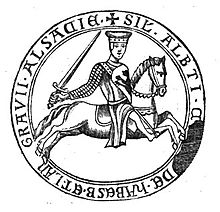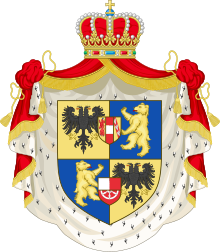Sophie, Duchess of Hohenberg
Sophie | |
|---|---|
Condominium of Bosnia and Herzegovina, Austria-Hungary | |
| Buried | Artstetten Castle, Artstetten-Pöbring |
| Noble family | |
| Spouse(s) | |
| Issue | |
| Father | Count Bohuslaw Chotek von Chotkow und Wognin |
| Mother | Countess Wilhelmine Kinsky von Wchinitz und Tettau |
Sophie, Duchess of Hohenberg (
Early life
Countess Sophie Chotek von Wognin was born in
As a young woman, Sophie became a lady-in-waiting to Archduchess Isabella,[3] the wife of Archduke Friedrich, Duke of Teschen, head of the Bohemian cadet branch of the House of Habsburg-Lorraine.
Courtship with Franz Ferdinand
It is unknown where Sophie first met Archduke Franz Ferdinand, although it may have been at a ball in Prague in 1894. Franz Ferdinand, who was stationed at a military garrison in Prague, paid frequent visits to Halbturn Castle, the home of Archduke Friedrich, and it was assumed that he had fallen in love with Friedrich's eldest daughter, Archduchess Marie Christine.[3] The liaison was discovered by Archduchess Isabella, herself only born into a mediatised family (the House of Croÿ). When Isabella discovered Franz Ferdinand's locket lying on the tennis court, she opened it, expecting a photo of her daughter. Instead, the locket contained a photo of Sophie. From this, a scandal ensued.
Franz Ferdinand had become

Franz Ferdinand refused to renounce Sophie to marry equally and beget an heir to the throne, compounding the scandal surrounding the death and illicit affair of the emperor's previous heir.
Marriage with Franz Ferdinand
In 1899, under pressure from family members (especially the
Sophie and Franz Ferdinand were married on 1 July 1900 at Reichstadt (now Zákupy) in Bohemia. The Emperor did not attend the nuptials, nor did any of the archdukes, including Franz Ferdinand's brothers. The only members of the Imperial family who were present were Franz Ferdinand's stepmother, Archduchess Maria Theresa, and her two daughters, Maria Annunciata and Elisabeth Amalie.[3]
Upon her marriage, Sophie was given the title
Nonetheless, all of the archduchesses,
The couple had four children:[4]
- Princess Sophie of Hohenberg (1901–1990), married Count Friedrich von Nostitz-Rieneck (1891–1973)
- Maximilian, Duke of Hohenberg (1902–1962), married Countess Elisabeth von Waldburg zu Wolfegg und Waldsee (1904–1993). His descendants married descendants of the Royal Houses of France and Portugal and Austria (Archduke Joseph Arpad).
- Prince Ernst of Hohenberg (1904–1954), married Marie-Therese Wood (1910–1985)
- stillborn son (1908)
Assassination

In 1914, Archduke Franz Ferdinand was invited by General Oskar Potiorek, Governor of the Austro-Hungarian province of Bosnia and Herzegovina, to watch troops on maneuvers for three days in Sarajevo, the provincial capital. Sophie was not usually allowed to accompany her husband on ceremonial visits because of her lower status, but on this occasion, Franz Ferdinand was invited as a military commander rather than a royal personage.[8]: 17 The archduke therefore arranged for Sophie to join him on 28 June, the third and final day, for a troop review followed by a visit to the city to dedicate a new museum before returning to Vienna. The date coincided with the 14th anniversary of their Oath of Renunciation and was a rare opportunity to celebrate in public together, although he knew that the visit would be dangerous.[citation needed]
At 10:10 am of Sunday, 28 June 1914, when the procession passed the Sarajevo central police station,
After attending the official reception at the
In order to avoid the city centre, Potiorek decided that the Imperial car should travel straight along the
The driver put his foot on the brake, and began to back up. In doing so he moved slowly past the waiting Gavrilo Princip. The assassin stepped forward, drew his pistol, and at a distance of about five feet, fired twice into the car. Franz Ferdinand was hit in the neck and Sophie in the abdomen. Sophie said to her husband, "For God's sake, what has happened to you?!" She then fell bleeding. Before losing consciousness he pleaded, "Sopherl! Sopherl! Don't die! Stay alive for our children!", using his pet name for the duchess.[8]: 11 They were both dead within an hour.[citation needed]
The assassination triggered the
Funeral and burial
The bodies were transported to

Commemorative coin
Duchess Sophie's castle of
Titles, styles, honours and arms


Titles and styles
- 1 March 1868 – 1 July 1900: Countess Sophie Chotek von Chotkow und Wognin
- 1 July 1900 – 1905: Her Grace The Princess of Hohenberg
- 1905 – 4 October 1909: Her Serene Highness The Princess of Hohenberg
- 4 October 1909 – 28 June 1914: Her Highness The Duchess of Hohenberg
Honours

 Austria-Hungary:[11]
Austria-Hungary:[11]
- Dame of the Order of the Starry Cross, 1889[12]
- Grand Cross of the Imperial Austrian Order of Elizabeth, 1913[12]
 Kingdom of Bavaria: Dame of Honour of the Order of Saint Elizabeth[11]
Kingdom of Bavaria: Dame of Honour of the Order of Saint Elizabeth[11] Order of the Holy Sepulchre of Jerusalem[11]
Order of the Holy Sepulchre of Jerusalem[11] Sovereign Military Order of Malta: Dame of Honour and Devotion[13]
Sovereign Military Order of Malta: Dame of Honour and Devotion[13]
Ancestry
| Ancestors of Sophie, Duchess of Hohenberg | ||||||||||||||||||||||||||||||||||||||||||||||||||||||||||||||||||||||||||||||||||||||||
|---|---|---|---|---|---|---|---|---|---|---|---|---|---|---|---|---|---|---|---|---|---|---|---|---|---|---|---|---|---|---|---|---|---|---|---|---|---|---|---|---|---|---|---|---|---|---|---|---|---|---|---|---|---|---|---|---|---|---|---|---|---|---|---|---|---|---|---|---|---|---|---|---|---|---|---|---|---|---|---|---|---|---|---|---|---|---|---|---|
| ||||||||||||||||||||||||||||||||||||||||||||||||||||||||||||||||||||||||||||||||||||||||
References
- ISBN 0-220-66222-3
- ^ Willis, Daniel A., The Descendants of King George I of Great Britain, Clearfield Company, 2002, pp. 153, 613
- ^ a b c d e f g h i Enache, Nicolas. La Descendance de Marie-Therese de Habsburg. ICC, Paris, 1996. pp. 54, 58. French.
- ^ a b Genealogisches Handbuch des Adels, Fürstliche Häuser XV. "Hohenberg". C.A. Starke Verlag, 1997, pp.600–601.
- ^ "Pragmatic Sanction of 1713". heraldica.org. 2011. Retrieved 11 November 2011.
- , retrieved 14 April 2022
- ^ "Austria Will Avenge Murder". The Winnipeg Tribune. 29 June 1914. p. 1.
- ^ ISBN 978-1-74045-970-9.
- ^ "Time Magazine Milestones (as Leopold Lojka)". Time.com. 9 August 1926. Archived from the original on 12 November 2007. Retrieved 8 July 2012.
- ^ "The Funeral of the Archduke". The Independent. New York. 13 July 1914. p. 59. Retrieved 9 August 2013.
- ^ a b c Hof- und Staatshandbuch der Österreichisch-Ungarischen Monarchie (1915), Genealogy p. 2
- ^ a b "Ritter-orden", Hof- und Staatshandbuch der Österreichisch-Ungarischen Monarchie, Vienna: Druck und Verlag der K.K. Hof- und Staatsdruckerei, 1914, pp. 232, 246
- ^ Justus Perthes, Almanach de Gotha (1913) page 6
Further reading
- Brook-Shepherd, Gordon. Victims at Sarajevo: The Romance and Tragedy of Franz Ferdinand and Sophie (Harvill, 1984)



